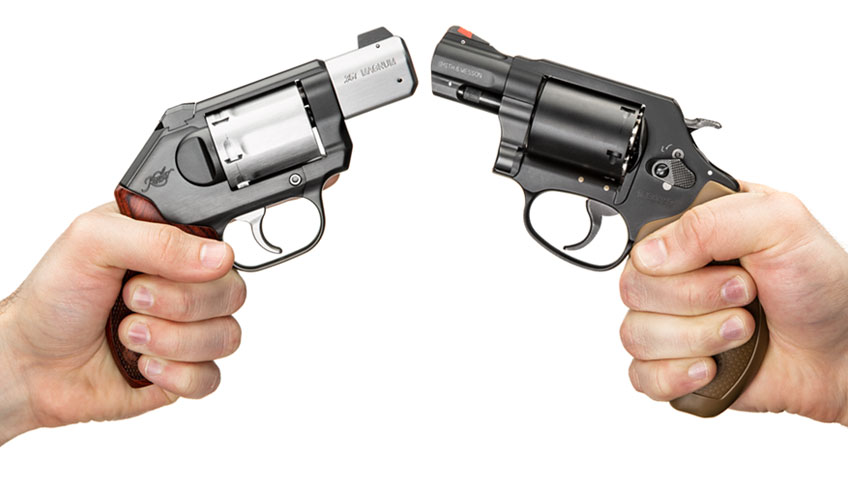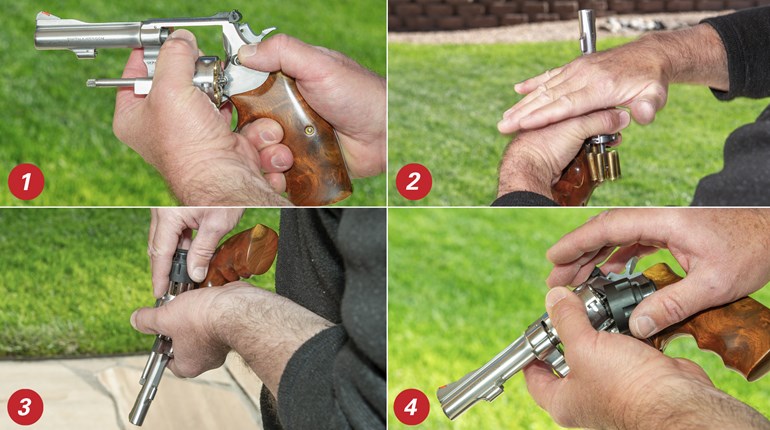
Snub-nose revolvers remain popular with concealed carriers despite the advent of reliable, compact semi-automatic pistols. While demand for 4- and 6-inch-barreled “duty” revolvers has dropped off, the market for snubbies is stronger than ever. What’s a snubbie? They’re 2- to 3-inch-barreled revolvers, most often seen in .38 Spl. and .357 Mag. calibers. They’re the choice of many concealed carriers and have remained popular as police backup guns because they are hard to beat as up-close-and-personal fight stoppers.
If there’s a downside to snubbies for self-defense, it centers around their limited ammunition capacity of five or six rounds. On the other hand, outside of a few military and police shootings, most personal-defense situations are settled with the ammunition in the gun. If there’s a need to reload, the fastest method—by far—is a second gun, and this is why a lot of folks who’ve spent some time thinking about this issue choose to carry two snubbies. There are a number of ways to accomplish this. Two revolvers in belt holsters, one on each side, guarantees a quick reload, dubbed by famed NYC police officer Jim Cirillo as a "New York Reload," and makes a gun available to either hand. Some folks opt for the spare gun to be carried in a pocket, ankle holster or shoulder holster, while a second revolver in a trouser or coat pocket remains a popular option.
If you’re going to carry two revolvers, you’ll need to practice shooting one-handed with either hand as well as shooting two-handed, then transitioning to the other gun. Think about what you do with the empty revolver. Do you drop it? Re-holster it? To safely practice these drills, it’s best to set it down on a table or shooting bench. Along with the table you’ll need two revolvers, a silhouette target and a supply of practice ammunition along with a few defensive rounds for each revolver. You might want to start and finish these drills with the defensive ammo and use practice ammo in between. I don’t know about you, but I concluded that shooting hot .357 Mag. ammunition in little revolvers is not a lot of fun, so I spend most of my practice time shooting milder loads. Here are some sample drills:
• 3 yards One-handed, five or six rounds with the strong hand, switch guns, five or six rounds with the support hand, starting from the holster.
• 3 yards Draw and fire two rounds, strong hand only. Repeat until empty.
• 3 yards Draw and fire two rounds, support hand only. Repeat until empty.
• 5 yards Draw and fire two rounds, strong hand, two-handed. Repeat until empty.
• 5 yards Draw and fire two rounds, support hand, two-handed. Repeat until empty.
• 7 yards Stepping to the side as you draw, fire two rounds, strong hand, two-handed. Repeat until empty.
• 7 yards Stepping to the side as you draw, fire two rounds, support hand, two-handed. Repeat until empty.
Depending upon the capacity of your revolvers, these drills will consume about a box of ammunition and should give you a better understanding of the credo that the fastest reload is a second gun.





































